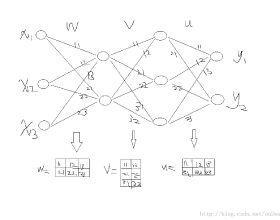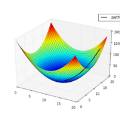豆瓣9.4!《深度学习入门:基于Python的理论与实现》学习笔记(2)
点击上方,选择星标或置顶,每天给你送干货
阅读大概需要20分钟
跟随小博主,每天进步一丢丢
-
梯度 -
神经网络计算梯度的实现(利用数值微分) -
学习算法的实现步骤 -
利用误差反向传播法求梯度(更高速) -
激活函数层反向传播的实现 -
利用误差反向传播法实现两层神经网络的学习

-
寻找函数的最小值
-
通过数值微分计算梯度。梯度下降的地方,就是函数在变小的地方。直到梯度下降为0,这个函数的局部最小值也就找到啦。

def gradient_descent(f, init_x, lr=0.01, step_num=100): # step_num为更新次数
x = init_x
for i in range(step_num):
grad = numerical_gradient(f, x)
x -= lr * grad
return x

import sys, os
sys.path.append(os.pardir)
import numpy as np
from common.functions import softmax, cross_entropy_error
from common.gradient import numerical_gradient
class simpleNet:
def __init__(self):
self.W = np.random.randn(2,3) # 用高斯分布进行初始化(正态分布)
def predict(self, x):
return np.dot(x, self.W)
def loss(self, x, t):
z = self.predict(x)
y = softmax(z)
loss = cross_entropy_error(y, t)
return loss
也就是梯度下降法逐渐更新函数的过程
-
前提 神经网络存在合适的权重和偏置,调整权重和偏置以便拟合训练数据的过程称为“学习”。
-
步骤1(mini-batch) 从训练数据中随机选出一部分数据,这部分数据称为mini-batch。我们的目标是减小mini-batch的损失函数的值。
-
步骤2(计算梯度) 为了减小mini-batch的损失函数的值,需要求出各个权重参数的梯度。梯度表示损失函数的值减小最多的方向。
-
步骤3(更新参数) 将权重参数沿梯度方向进行微小更新。
-
步骤4(重复) 重复步骤1、步骤2、步骤3。
import sys, os
sys.path.append(os.pardir)
from common.functions import *
from common.gradient import numerical_gradient
class TwoLayerNet:
def __init__(self, input_size, hidden_size, output_size,
weight_init_std=0.01):
# 1、初始化权重
self.params = {}
self.params['W1'] = weight_init_std * \
np.random.randn(input_size, hidden_size)
self.params['b1'] = np.zeros(hidden_size)
self.params['W2'] = weight_init_std * \
np.random.randn(hidden_size, output_size)
self.params['b2'] = np.zeros(output_size)
# 2、神经网络的推理过程(已知权重参数,进行前向传播)
def predict(self, x):
W1, W2 = self.params['W1'], self.params['W2']
b1, b2 = self.params['b1'], self.params['b2']
a1 = np.dot(x, W1) + b1
z1 = sigmoid(a1)
a2 = np.dot(z1, W2) + b2
y = softmax(a2)
return y
# 3、损失函数的选择
# x:输入数据, t:监督数据
def loss(self, x, t):
y = self.predict(x)
return cross_entropy_error(y, t)
# 4、网络的识别精度,判断网络的精确度
def accuracy(self, x, t): #
y = self.predict(x)
y = np.argmax(y, axis=1)
t = np.argmax(t, axis=1)
accuracy = np.sum(y == t) / float(x.shape[0])
return accuracy
# 利用数值微分求梯度
# x:输入数据, t:监督数据
def numerical_gradient(self, x, t):
loss_W = lambda W: self.loss(x, t)
grads = {}
grads['W1'] = numerical_gradient(loss_W, self.params['W1'])
grads['b1'] = numerical_gradient(loss_W, self.params['b1'])
grads['W2'] = numerical_gradient(loss_W, self.params['W2'])
grads['b2'] = numerical_gradient(loss_W, self.params['b2'])
return grads

import numpy as np
from dataset.mnist import load_mnist
from two_layer_net import TwoLayerNet
# 加载输入训练数据
(x_train, t_train), (x_test, t_test) = \ load_mnist(normalize=True, one_hot_
laobel = True)
train_loss_list = []
# 超参数
iters_num = 10000 # 使用随机梯度下降法(SGD)更新参数、循环10000次
train_size = x_train.shape[0]
batch_size = 100 # 随机选择100笔mini-batch数据
learning_rate = 0.1
network = TwoLayerNet(input_size=784, hidden_size=50, output_size=10)
for i in range(iters_num):
# 获取mini-batch
batch_mask = np.random.choice(train_size, batch_size)
x_batch = x_train[batch_mask]
t_batch = t_train[batch_mask]
# 计算梯度
grad = network.numerical_gradient(x_batch, t_batch)
# grad = network.gradient(x_batch, t_batch) # 计算梯度的高速版!也就是接下来会说的反向传播法
# 更新参数
for key in ('W1', 'b1', 'W2', 'b2'):
network.params[key] -= learning_rate * grad[key]
# 记录学习过程,不断拟合的过程
loss = network.loss(x_batch, t_batch)
train_loss_list.append(loss)

计算图:将计算过程用图形表示出来。就像流程图一样。由节点,输入输出和箭头来表示他们之间的关系。


-
将信号 E × 节点的局部导数(偏导数),再传递给下一节点



加法节点的反向传播原封不动的传给下一个节点。










class Relu:
def __init__(self):
self.mask = None
def forward(self, x):
self.mask = (x <= 0)
out = x.copy()
out[self.mask] = 0
return out
def backward(self, dout):
dout[self.mask] = 0
dx = dout
return dx
-
正向传播时,有电流通过的话,开关设为ON;没有电流通过,开关设为OFF。 -
反向传播时,开关为ON,电流会直接通过;开关为OFF,则不会有电流通过






#(实现的代码在 common/layers.py中)
class Sigmoid:
def __init__(self):
self.out = None
def forward(self, x):
out = 1 / (1 + np.exp(-x))
self.out = out
return out # 正向传播时将输出 y 保存在了实例变量 out中
def backward(self, dout):
dx = dout * (1.0 - self.out) * self.out
return dx

-
包括一次线性变换和一次平移,分别对应神经网络的加权和运算与加偏置运算,将进行该仿射变换的处理实现为“Affine层”

class Affine:
def __init__(self, W, b):
self.W = W
self.b = b
self.x = None
self.dW = None
self.db = None
def forward(self, x):
self.x = x
out = np.dot(x, self.W) + self.b
return out
def backward(self, dout): # 反向传播
dx = np.dot(dout, self.W.T)
self.dW = np.dot(self.x.T, dout)
self.db = np.sum(dout, axis=0)
return dx


class SoftmaxWithLoss:
def __init__(self):
self.loss = None # 损失
self.y = None # softmax的输出
self.t = None # 监督数据(one-hot vector)
def forward(self, x, t):
self.t = t
self.y = softmax(x)
self.loss = cross_entropy_error(self.y, self.t)
return self.loss
def backward(self, dout=1):
batch_size = self.t.shape[0]
dx = (self.y - self.t) / batch_size # 反向传播
return dx
-
前提 神经网络中有合适的权重和偏置,调整权重和偏置以便拟合训练数据的过程称为学习。神经网络的学习分为下面4个步骤。 -
步骤1(mini-batch) 从训练数据中随机选择一部分数据。 -
步骤2(计算梯度) 计算损失函数关于各个权重参数的梯度。(计算梯度:数值微分法和误差反向传播法) -
步骤3(更新参数) 将权重参数沿梯度方向进行微小的更新。 -
步骤4(重复) 重复步骤1、步骤2、步骤3。
import sys, os
sys.path.append(os.pardir)
import numpy as np
from common.layers import *
from common.gradient import numerical_gradient
from collections import OrderedDict
class TwoLayerNet:
def __init__(self, input_size, hidden_size, output_size,
weight_init_std=0.01): # 进行属性的初始化
# 参数从头开始依次是输入层的神经元数、隐藏层的神经元数、输出层的神经元数、初始化权重时的高斯分布的规模
# 初始化权重
self.params = {}
self.params['W1'] = weight_init_std * \
np.random.randn(input_size, hidden_size)
self.params['b1'] = np.zeros(hidden_size)
self.params['W2'] = weight_init_std * \
np.random.randn(hidden_size, output_size)
self.params['b2'] = np.zeros(output_size)
# 生成所需要的层
self.layers = OrderedDict() # 有序字典
self.layers['Affine1'] = \ # w1*x + b1
Affine(self.params['W1'], self.params['b1'])
self.layers['Relu1'] = Relu()
self.layers['Affine2'] = \ # w2*x + b2
Affine(self.params['W2'], self.params['b2'])
self.lastLayer = SoftmaxWithLoss() #SoftmaxWithLoss层
def predict(self, x): # 前向传播
for layer in self.layers.values():
x = layer.forward(x)
return x
# 计算损失函数的值。
# x:输入数据, t:监督数据
def loss(self, x, t):
y = self.predict(x)
return self.lastLayer.forward(y, t)
# 计算识别精度
def accuracy(self, x, t):
y = self.predict(x)
y = np.argmax(y, axis=1)
if t.ndim != 1 : t = np.argmax(t, axis=1)
accuracy = np.sum(y == t) / float(x.shape[0])
return accuracy
# x:输入数据, t:监督数据
# 数值微分法计算梯度
def numerical_gradient(self, x, t):
loss_W = lambda W: self.loss(x, t)
grads = {}
grads['W1'] = numerical_gradient(loss_W, self.params['W1'])
grads['b1'] = numerical_gradient(loss_W, self.params['b1'])
grads['W2'] = numerical_gradient(loss_W, self.params['W2'])
grads['b2'] = numerical_gradient(loss_W, self.params['b2'])
return grads
# 利用误差反向传播法计算关于权重参数的梯度
def gradient(self, x, t):
# forward
self.loss(x, t)
# backward
dout = 1
dout = self.lastLayer.backward(dout)
layers = list(self.layers.values())
layers.reverse() # 反转列表的顺序,反向传播只需要按照相反的顺序条用各层即可
for layer in layers:
dout = layer.backward(dout)
# 设定
grads = {}
grads['W1'] = self.layers['Affine1'].dW
grads['b1'] = self.layers['Affine1'].db
grads['W2'] = self.layers['Affine2'].dW
grads['b2'] = self.layers['Affine2'].db
return grads
-
可以利用梯度确认(gradient check),确认数值微分求出的梯度结果和误差反向传播法求出的结果是否一致。
# (源代码在 ch05/gradient_check.py中)。
import sys, os
sys.path.append(os.pardir)
import numpy as np
from dataset.mnist import load_mnist
from two_layer_net import TwoLayerNet
# 读入数据
(x_train, t_train), (x_test, t_test) = \ load_mnist(normalize=True, one_
hot_label = True)
network = TwoLayerNet(input_size=784, hidden_size=50, output_size=10)
x_batch = x_train[:3]
t_batch = t_train[:3]
grad_numerical = network.numerical_gradient(x_batch, t_batch)
grad_backprop = network.gradient(x_batch, t_batch)
# 求各个权重的绝对误差的平均值
for key in grad_numerical.keys():
diff = np.average( np.abs(grad_backprop[key] - grad_numerical[key]) )
print(key + ":" + str(diff))
这个学习过程中只是求梯度的方法与之前不同。
import sys, os
sys.path.append(os.pardir)
import numpy as np
from dataset.mnist import load_mnist
from two_layer_net import TwoLayerNet
# 读入数据
t_train), (x_test, t_test) = \
load_mnist(normalize=True, one_hot_label=True)
network = TwoLayerNet(input_size=784, hidden_size=50, output_size=10)
iters_num = 10000
train_size = x_train.shape[0]
batch_size = 100
learning_rate = 0.1
train_loss_list = []
train_acc_list = []
test_acc_list = []
iter_per_epoch = max(train_size / batch_size, 1)
for i in range(iters_num):
batch_mask = np.random.choice(train_size, batch_size)
x_batch = x_train[batch_mask]
t_batch = t_train[batch_mask]
# 通过误差反向传播法求梯度
grad = network.gradient(x_batch, t_batch)
# 更新
for key in ('W1', 'b1', 'W2', 'b2'):
-= learning_rate * grad[key]
loss = network.loss(x_batch, t_batch)
train_loss_list.append(loss)
if i % iter_per_epoch == 0:
train_acc = network.accuracy(x_train, t_train)
test_acc = network.accuracy(x_test, t_test)
train_acc_list.append(train_acc)
test_acc_list.append(test_acc)
print(train_acc, test_acc)




登录查看更多
相关内容
反向传播一词严格来说仅指用于计算梯度的算法,而不是指如何使用梯度。但是该术语通常被宽松地指整个学习算法,包括如何使用梯度,例如通过随机梯度下降。反向传播将增量计算概括为增量规则中的增量规则,该规则是反向传播的单层版本,然后通过自动微分进行广义化,其中反向传播是反向累积(或“反向模式”)的特例。
在机器学习中,反向传播(backprop)是一种广泛用于训练前馈神经网络以进行监督学习的算法。对于其他人工神经网络(ANN)都存在反向传播的一般化–一类算法,通常称为“反向传播”。反向传播算法的工作原理是,通过链规则计算损失函数相对于每个权重的梯度,一次计算一层,从最后一层开始向后迭代,以避免链规则中中间项的冗余计算。





